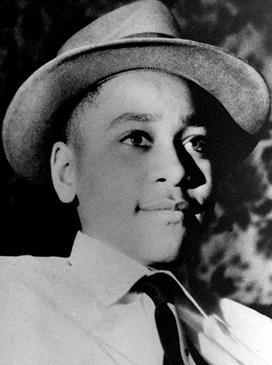Recently in English class, we talked about Emmett Till, a 14 year old African American boy who was brutally murdered and drowned in a river by two American men, during the time when the Jim Crow Laws were in place. But what crime was committed to face such consequences?
 |
| 14 year old Emmett Till from Chicago |
On August 1955, Emmett came from Chicago to visit his cousins down in Mississippi. In the north, segregation wasn't as strict as it was in the south. His cousins were surprised when they learned this from Emmett and dared him to talk to a white woman. Emmett, not knowing the mistake of his actions, walked into a store and while leaving catcalled to the owner's wife, Carolyn Bryant. A few days later Emmett was kidnapped late at night by Carolyn's husband, Roy Bryant, and his brother, J.W. Milam, and taken into a barn. Emmett was beat up badly, had one of his eyes gouged, and was shot in the head. The two, then tied a 70 pound cotton gin with barbed wire around his neck and disposed his body in the Tallahatchie River. Three days later, Emmett's body was spotted floating in the river.
 |
| The barn where Emmett was beaten up in remains standing in Money, Mississippi |
Till's body was shipped to Chicago to his mother, Mamie Carthan, who insisted on having an open casket funeral. Her reason was to let everyone know the enormity of the men's doings. Over 600,000 viewed Emmett's body before his funeral, many were shocked and bewildered.
Emmett's case went to court and the trial lasted for five drawn out days. The case is known as the first great media event of the Civil Rights Movement, as it is one of the cases which were closely monitored through the media. But, naturally, Bryant and Miliam were "proven" to be innocent, leaving the audience with mixed emotions. To this date, Emmett Till is remembered through literature and media, for his remarkable footprint on the history and culture of African Americans.
 |
| Till's empty casket found buried in the graveyard still intact |
I thought this incident had a close connection to the recent slavery topic in history class. Even though the slave trade was abolished in 1807 and slavery was ended in 1865 after the Thirteenth Amendment, signs of racism was still seen a couple decades later. Emmett's casket was found in 2009 and now is displayed in the Smithsonian's National Museum of African American History and Culture reminding visitors of this atrocious occurrence.
“As you grow older, you'll see white men cheat black men every day of your life, but let me tell you something and don't you forget it - whenever a white man does that to a black man, no matter who he is, how rich he is, or how fine a family he comes from, he is trash.” ― Harper Lee, To Kill a Mockingbird
Bibliography & Pictography
http://adiama.com/ancestralconnections/2009/11/09/emmett-tills-casket-goes-to-the-smithsonian/http://www.nytimes.com/2005/07/31/magazine/31TILL.html?pagewanted=all&_r=0http://www.goodreads.com/quotes/tag/racism



I really liked your post Akka! I liked the fact that you went into a lot more detail of what actually happened than what we learned in English class. I like that you added a To Kill a Mockingbird quote since we just finished reading that in class. The only criticism I have is go into a little more detail of how this is related to what we learned in History Class. Awesome job! :)
ReplyDeleteThis was a very phenomenal post. Its sad to see what happened to this child and I really was engaged in the story behind it. I enjoyed the connection to the the class, but I think it could have been a little more towards History class not English, but overall it was a very good post.
ReplyDeleteThis is fantastic Akshita! I liked how you went into such detail about the Emmett Till case, even though I am in your English class. I guarantee it was very helpful to those who aren't. I also liked how you could relate the two classes, English and History. It's so horrible how this boy was treated. It horrid that it took so long to get any kind of racial equality.
ReplyDeleteI love how you connected it to another class, especially how specific it was. The details were great but I recommend you focus more on History and what you learned in this class, and less on English.
ReplyDeleteThis is a great post! Your descriptions were great and really made me understand what you were saying. Good job for going above and beyond and connecting this to two classes.
ReplyDeleteAs someone who also read this story for class, I think you did a great job of capturing the essence of how tragic it truly was. However, I think if you had just stayed more on the topic of History rather than English then this post would've been 100% ideal. Overall, great job!
ReplyDelete